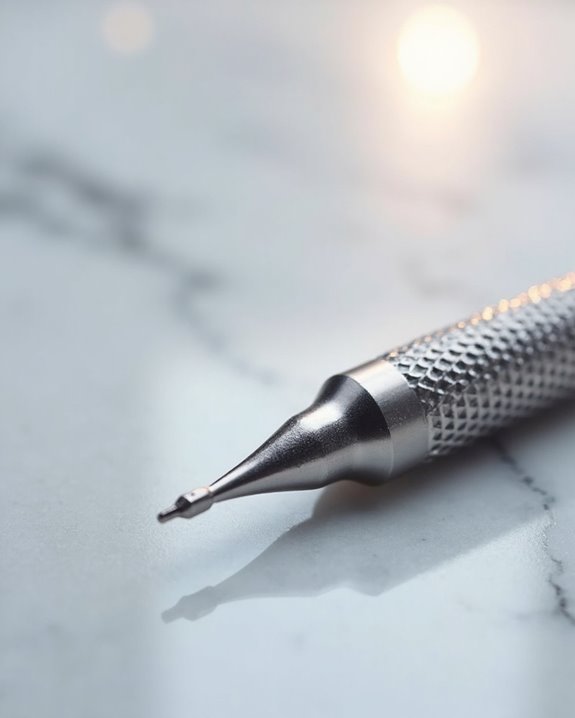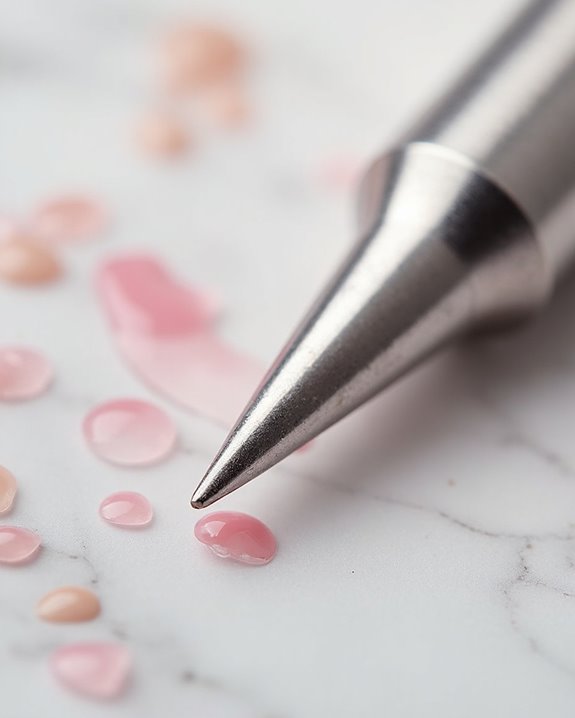Nail drill bits serve specific functions based on their shape and material. Barrel bits excel at surface work and shaping, while needle bits clean under nails and tight spaces. Ball-shaped bits address hard skin and cuticle removal, and cone bits provide precision for cuticle preparation. Material choices include durable carbide for heavy-duty tasks, ceramic for heat reduction, and diamond for detailed work. Grit levels range from coarse for rapid removal to fine for polishing and finishing. Understanding these distinctions guarantees best results for every nail service.
Key Takeaways
- Barrel/Cylinder bits are used for surface work, backfill cutting, smile line creation, and shaping the nail plate.
- Needle bits clean under nails and sidewalls, access tight spaces, and create decorative elements due to their pointed design.
- Ball Top Shape bits remove loose cuticle, clean the eponychium area, and address hard skin with controlled abrasion.
- Carbide bits handle heavy-duty tasks like acrylic removal, while ceramic bits minimize heat generation for natural nail work.
- Diamond bits provide superior cutting power for precise cuticle work, detailed shaping, and smoothing nail surfaces.
8 SECOND-LEVEL HEADINGS
The selection of appropriate nail drill bits proves essential for achieving professional-quality nail treatments, with each bit type serving specific functions in the manicure process. Barrel/Cylinder bits excel at surface work, including backfill cutting and creating smile lines, while UNC/Needle bits, with their pointed design, effectively clean under nails and sidewalls. Ball Top Shape bits address hard skin and remove loose cuticle from the nail plate, complementing the Diamond Cuticle Nail Drill Bits Set. Cone bits, featuring a tapered design, work well for cuticle preparation and toenail surface work, though they should be avoided on fingernail surfaces. Safety bits, rounded at the top, provide secure cuticle and sidewall work without damaging the nail, making them ideal for in-fill procedures where precision meets protection. Additionally, incorporating diamond carbide bits into your toolkit can minimize heat generation for enhanced precision during detailed manicure tasks.
Understanding Nail Drill Bit Materials
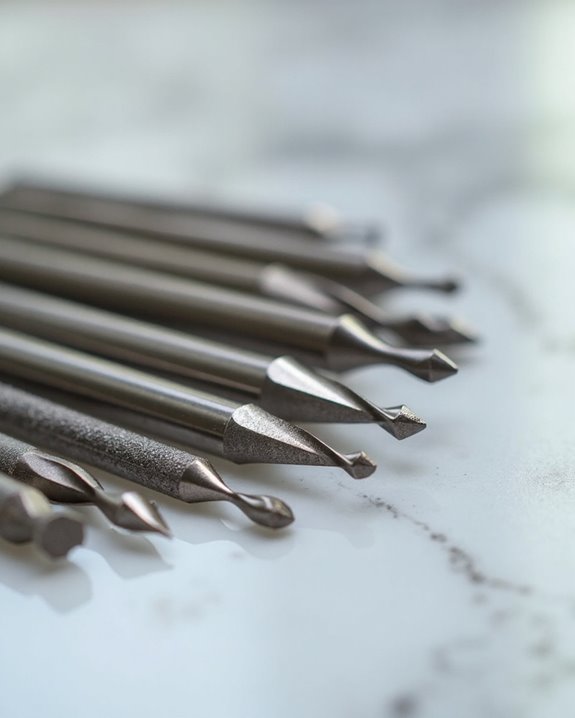
Selecting appropriate nail drill bit materials greatly impacts both performance and longevity when providing professional nail services. The variety of materials available for nail drill bits serves different functions in nail enhancements and maintenance. Carbide nail drill bits, typically gold or silver tungsten carbide nail drill options, offer exceptional durability and reusability, making them cost-effective for acrylic removal. Ceramic bits feature specialized flute cuts that minimize heat generation during use, allowing for enhanced client comfort and easier sterilization.
Mandrel bits, constructed from rubber or metal cylinders, are designed specifically to hold disposable sanding bands of varying grits. Unlike solid bits, these sanding bands come in fine, medium, and coarse options but cannot be reused after application. The materials of nail drill bits determine not only their function but also their maintenance requirements and lifespan in professional settings.
Additionally, ceramic nail drill bits are favored for their heat dissipation properties, which help prevent discomfort and nail damage during extended use.
The Essential Guide to Bit Shapes and Their Functions

Mastering nail technicians recognize that different nail drill bit shapes serve specialized functions, creating the foundation for precise, professional manicure and pedicure services. Barrel bits excel at surface work, backfilling, and shaping the nail plate, while Tapered Barrel variations allow for more detailed contouring. Diamond Nail Drill Bits in ball top shapes effectively address hard skin and clean the eponychium area with controlled abrasion. For cuticle area work, Safety bits and Cone bits provide ideal results, with the latter’s slim design maneuvering sidewalls with precision. Carbide bits, available in multiple shapes, offer durability for artificial nail applications. Needle bits, with their pointed design, access tight spaces under nails and create decorative elements. Each shape serves a specific purpose, requiring technicians to select appropriately for both safety and efficacy. Additionally, ceramic bits are favored for their reduced heat generation and dust production, making them ideal for extended use in various bit shapes like those in specialized sets.
Choosing the Right Grit Level for Your Nail Services
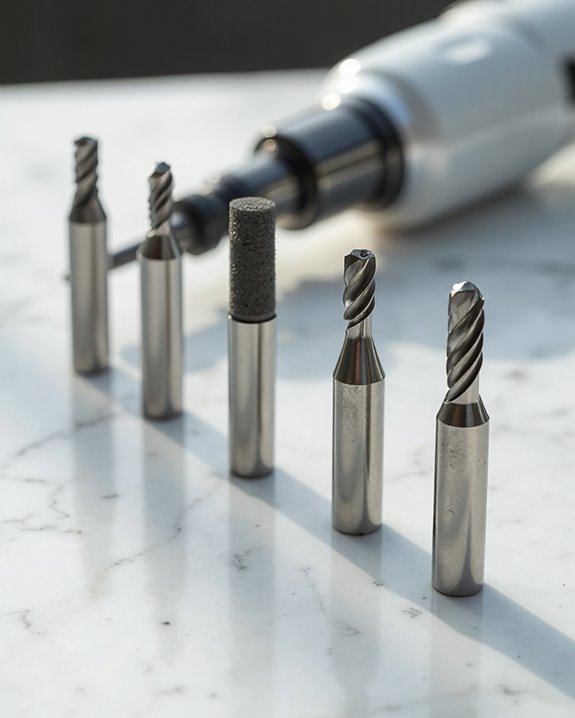
Why do professional nail technicians consider grit level one of the most important factors when selecting drill bits for specific services? The level of grit directly impacts efficiency and safety during nail procedures, determining how quickly material is removed and whether the natural nail remains protected.
Coarse bit options, featuring larger abrasive particles, are designed for rapid product removal from gel nails and acrylic nails, effectively cutting through layers without damaging the nail bed beneath. Medium grit bits balance speed with precision, making them ideal for in-fill work and natural nail shaping. Fine grit bits are used to remove dead skin, prepare cuticles, and create a smooth nail surface for polishing. Technicians should consider replacing bits every few months, as worn bits can create uneven results during services.
Comparing Ceramic vs. Carbide vs. Diamond Drill Bits
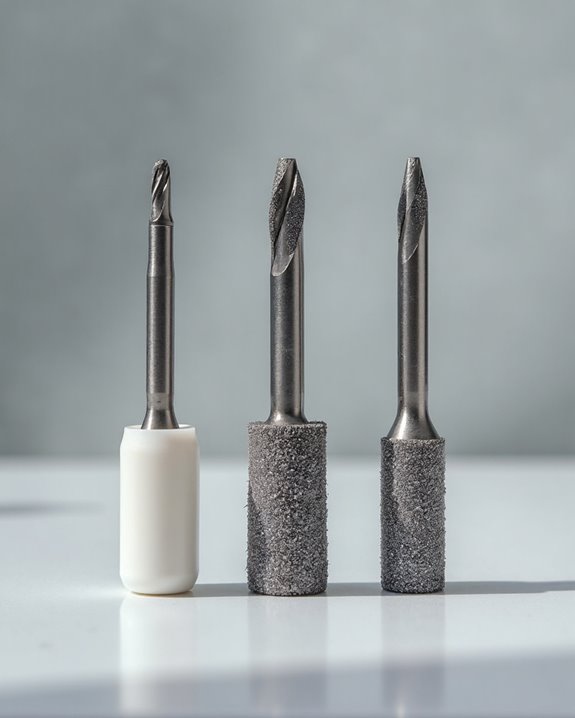
Professional nail technicians evaluate material composition as carefully as they assess grit levels when selecting their drill bits, with ceramic, carbide, and diamond options representing the primary categories available in the market today. Ceramic nail drill bits feature specialized flute cuts that minimize heat generation, making them ideal for natural nail work where temperature sensitivity is vital, while their smooth surfaces facilitate thorough cleaning and sterilization. Carbide drill bits offer exceptional longevity and reusability, constructed from high quality metal that excels in efficient acrylic removal and professional sanding applications. Diamond drill bits, distinguished by their abrasive coating, provide superior cutting power for precise cuticle work and detailed shaping, earning impressive ratings of up to 4.9 in customer reviews. Each material serves specific functions, with technicians selecting based on the particular demands of their services.
Multi-Function Bits: The 5-in-1 Revolution

The innovative 5-in-1 nail drill bits represent a significant advancement in nail technology, combining multiple functions into single, efficient tools that streamline professional workflows and reduce the need for constant bit changes. These tungsten carbide bits, available in various specifications including XL 5-in-1 Coarse ($15.99) and XL 5-in-1 Fine, feature multiple grits such as 3X Coarse, 2X Coarse, and X Coarse integrated into one design. The bits excel at addressing the cuticle area and sidewalls while offering different uses and purposes, from nail bed prepping to surface smoothing.
Available in colors like rose gold, purple, and black, these Top Large Barrel Carbide bits are great for surface work, earning exceptional ratings (4.9-5.0) from hundreds of reviewers who appreciate their multitasking capabilities in professional nail care settings.
Specialized Bits for Cuticle Work and Precision Tasks
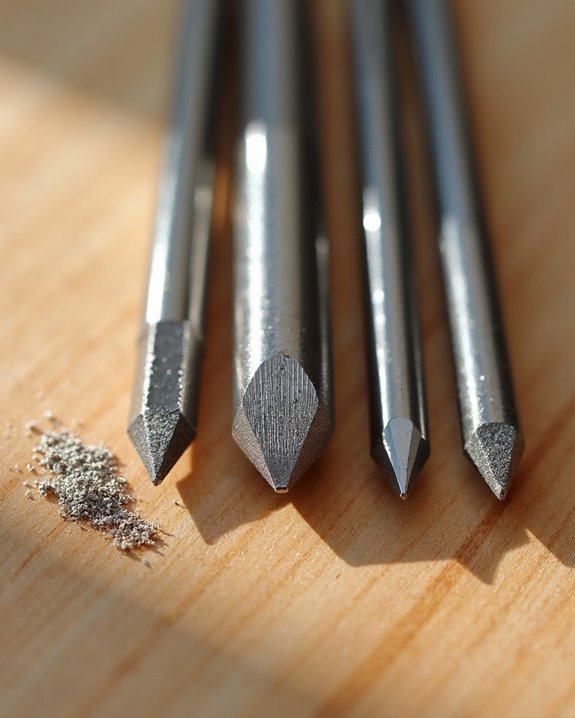
Precision in nail technician work reaches its peak with specialized cuticle bits, designed explicitly for delicate areas that require meticulous attention and control. Cuticle cleaner bits, often rounded at the top for safety, allow technicians to address loose cuticle and dead cuticle tissue without damaging the natural nail plate. Tungsten Carbide bits, available in various grits from Extra Fine to Medium, excel at cleaning sidewalls without damaging sensitive tissue, making them ideal for in-fill cuticle work.
Cone-shaped bits with their tapered edge provide exceptional maneuverability for removing hangnails and accessing difficult areas under nails. Ball top bits, specifically designed for Eponychium care, effectively clean the bit in the cuticle area while minimizing lifting risks, leading to longer-lasting nail applications with professional-quality results.
Proper Cleaning and Maintenance for Longer Bit Lifespan
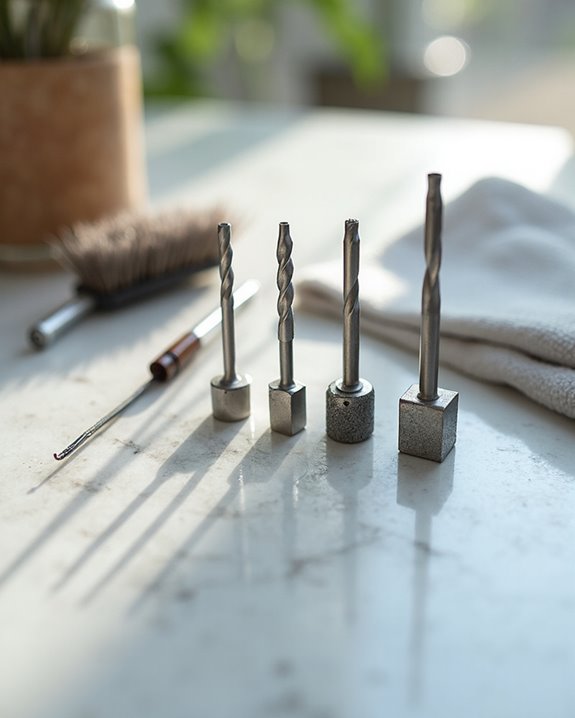
Investing in high-quality nail drill bits requires equally thoughtful maintenance routines to guarantee both longevity and client safety. The Ceramic Nail Drill bits are great investments that will last a long time when properly sanitized after each use, unlike disposable sanding bands. Professionals save valuable time when working with well-maintained tools that make life so much easier in busy salon environments.
To extend bit lifespan, implement two effective cleaning methods: either pre-soak in acetone for nail cleaning followed by disinfection and UV sterilization, or thoroughly scrub with soap and water. After cleaning, bits used to clean the nail surface must be completely dried and stored in organized containers to prevent moisture damage. Regular inspection guarantees Cleaner Safety standards are met, while making sure bits are immediately cleaned after each client prevents cross-contamination and maintains peak performance.
Frequently Asked Questions
How Do I Know Which Drill Bits to Use?
Ironically, bit selection isn’t rocket science. Users should check shank compatibility, match grit to task, consider bit material and shape, and evaluate quality. A thorough user guide and safety tips enhance technique and maintenance routines.
What Are the Different Drill Bits Used For?
Different nail drill bits serve specific functions while requiring proper maintenance. Bit materials affect durability, with regular cleaning methods extending lifespan. Usage frequency, speed settings, tool compatibility, and proper storage tips all influence drill safety and performance.
What Do the Colors of Nail Drill Bits Mean?
Nearly 70% of nail technicians recognize color-coded bits instantly. Drill bit color meanings often indicate material composition and functionality: rose gold suggests premium tungsten carbide, purple signifies heat resistance, while black denotes standard carbide construction for various nail applications.
Which Nail Bit Is for Shaping?
Barrel-shaped bits are the primary shaping tools for nail contours. Both tapered and standard barrel bit options offer varying precision levels for different usage scenarios. The 5-in-1 bits also provide versatile design aspects for efficient shaping techniques.


